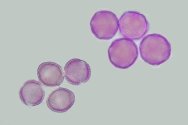
Dossier
Hay fever and pollen
Hay fever is an allergic reaction that is caused by pollen from trees, grasses and herbaceous plants. When this pollen is dispersed by the wind, people with hay fever suffer from sneezing, red and itchy eyes and a stuffy nose.
Weather conditions determine when 'hay fever plants' flower and how much pollen they release into the atmosphere. Every year, the progression of hay fever symptoms can differ. The daily pollen concentration in the atmosphere in the Netherlands is measured by the Leiden University Medical Center (LUMC) and Elkerliek Hospital in Helmond.
As part of the Nature’s Calendar observation programme, secondary school students and volunteers keep track of when various hay fever plants begin flowering. The students who conduct observations are also involved with the GLOBE Programme, an international education programme on the environmental sciences established in 1995 by Al Gore.
Knowledge about hay fever is limited
Ambrosia
One plant species that is known world-wide for causing hay fever symptoms is Ambrosia. This species, which is an exotic in the Netherlands, produces large amounts of strongly allergenic pollen. Moreover, the plant flowers late in the year, so the hay fever season for people who are sensitive to Ambrosia can be up to two months longer. Ambrosia originated from North America and has become widespread in the Netherlands because its seeds are unintentionally present in birdseed and wildflower mixtures. By removing plants before they begin flowering, nuisance from the pollen can be prevented, and the species is less likely to spread.
- Unfortunately, your cookie settings do not allow videos to be displayed. - check your settings
Publications on hay fever and pollen
-
Atlas Critical Tourism Studies - Asia Pacific Tourism (Event)
-
How is knowledge production and use practiced in transdisciplinary research collaboration? Examining routines for water transformation
-
Data underlying the publication "Nile crocodiles in Lake Nasser, Egypt, are found close to fishermen’s camps indicating potential conflicts"
-
From fibers to flowering to metabolites: unlocking hemp (Cannabis sativa) potential with the guidance of novel discoveries and tools
Journal of Experimental Botany (2025), Volume: 76, Issue: 1 - ISSN 0022-0957 - p. 109-123. -
Towards autonomous greenhouse crop production: virtual environment development, AI training and configuration
Wageningen University. Promotor(en): Leo F.M. Marcelis, co-promotor(en): Ep Heuvelink, Qingzhi Liu, T. Qian - Wageningen: Wageningen University - ISBN: 9789465104119 -
Landgoed De Lieskamp in bloei : Het versterken van de biodiversiteit
Wageningen: Wetenschapswinkel Wageningen (Rapport / Wageningen Wetenschapswinkel 409) -
Integrating UAV-based LiDAR and 3D computer vision to enhance cattle growth monitoring in precision livestock farming
Wageningen University. Promotor(en): Lammert Kooistra, Wensheng Wang, co-promotor(en): Caspar Alexander Mücher - Wageningen: Wageningen University - ISBN: 9789465104041 -
Can Arms Embargoes Stop the Weapon Transfers to Target States? An Exploratory Meta-Analysis
Defence and Peace Economics (2025), Volume: 36, Issue: 1 - ISSN 1024-2694 - p. 36-59. -
Contained Redistribution: The Technopolitics of Plastic Burning
Science Technology and Human Values (2025), Volume: 50, Issue: 1 - ISSN 0162-2439 - p. 197-227. -
Dataset underlying the study "Observations of Estuarine Salt Intrusion Dynamics During a Prolonged Drought Event in the Rhine-Meuse Delta"

